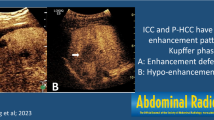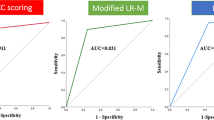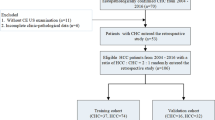Abstract
Purpose
To assess the diagnostic performance of the LR-M criteria of Contrast-Enhanced Ultrasound Liver Imaging Reporting and Data System version 2017 in differentiating intrahepatic cholangiocarcinoma (ICC) from hepatocellular carcinoma (HCC) in patients with and without risk factors for HCC.
Methods
Fifty-four ICC in patients with risks and 55 ICC in patients without risks and matched control cases of HCC with and without risks (n = 59 and n = 55, respectively) were enrolled. The enhanced features of the lesions were retrospectively analyzed according to LR-M criteria. The diagnostic performances including the area under the receiver operating characteristic curve (AUC), sensitivity, and specificity of LR-M criteria were assessed.
Result
Peripheral rim-like hyperenhancement, early washout (< 45 or 60s), and marked washout did not differ between ICCs with and without risks, while all of these features were more common in ICCs than in HCCs (p < 0.05) no matter if patients were with and without risk factors. Using the LR-M criteria to differentiate ICC from HCC, the AUC, sensitivity, specificity, and accuracy were 0.92, 97.25%, 87.72%, and 92.38%, respectively. If early washout onset was adjusted to < 45 s, the specificity was significantly increased to 95.61% (p = 0.004) without losing sensitivity (96.33%, p = 0.945). The rate of HCCs misdiagnosed as ICCs would decrease from 12.3 to 4.4%.
Conclusion
Although the LR-M criteria showed high sensitivity in distinguishing ICCs from HCCs in patients with and without risks, the specificity would be significantly increased after adjustments to current criteria.
Key Points
• The LR-M criteria of CEUS-LI-RADS v2017 could be used for distinguishing ICC from HCC not only in patients with risk factors for HCC but also in those without risk factors.
• The diagnostic performance of differentiating ICC from HCC by using the LR-M criteria showed high AUC (0.92), high sensitivity (97.25%), intermediate specificity (87.72%), and high accuracy (92.38%).
• If the onset of early washout was adjusted to < 45 s, the specificity was significantly increased from 87.72 to 95.61% (p = 0.004) without losing sensitivity (p = 0.945), and the rate of HCCs misdiagnosed as ICCs would decrease from 12.3 to 4.4%.



Similar content being viewed by others
Abbreviations
- AASLD:
-
American Association for the Study of Liver Diseases
- ACR:
-
American College of Radiology
- AUC:
-
Area under the ROC curve
- BUS:
-
B-mode ultrasound
- CEUS:
-
Contrast-enhanced ultrasound
- CT:
-
Computed tomography
- EASL:
-
European Association for the Study of the Liver
- HBV:
-
Hepatitis B virus
- HCC:
-
Hepatocellular carcinoma
- ICC:
-
Intrahepatic cholangiocarcinoma
- LI-RADS:
-
Liver Imaging Reporting and Data System
- MRI:
-
Magnetic resonance imaging
- Rim APHE:
-
Rim-like arterial phase hyperenhancement
- ROC:
-
Receiver operating characteristic
- TACE:
-
Transarterial chemoembolization
References
Massarweh NN, El-Serag HB (2017) Epidemiology of hepatocellular carcinoma and intrahepatic cholangiocarcinoma. Cancer Control 24:107327481772924
Choi SH, Lee SS, Kim SY et al (2017) Intrahepatic cholangiocarcinoma in patients with cirrhosis: differentiation from hepatocellular carcinoma by using gadoxetic acid-enhanced MR imaging and dynamic CT. Radiology 282:771–781
Blechacz B, Gores GJ (2008) Cholangiocarcinoma: advances in pathogenesis, diagnosis, and treatment. Hepatology 48:308–321
Mavros MN, Economopoulos KP, Alexiou VG et al (2014) Treatment and prognosis for patients with intrahepatic cholangiocarcinoma. JAMA Surg 149:565
Bridgewater J, Galle PR, Khan SA et al (2014) Guidelines for the diagnosis and management of intrahepatic cholangiocarcinoma. J Hepatol 60:1268–1289
Zhang H, Yang T, Wu M, Shen F (2016) Intrahepatic cholangiocarcinoma: epidemiology, risk factors, diagnosis and surgical management. Cancer Lett 379:198–205
Joo I, Lee JM, Yoon JH (2018) Imaging diagnosis of intrahepatic and Perihilar cholangiocarcinoma: recent advances and challenges. Radiology 288:7–13
Bohle W, Clemens PU, Heubach T, Zoller WG (2012) Contrast-enhanced ultrasound (CEUS) for differentiating between hepatocellular and cholangiocellular carcinoma. Ultraschall Med 33:E191–E195
Chen LD, Xu HX, Xie XY et al (2010) Intrahepatic cholangiocarcinoma and hepatocellular carcinoma: differential diagnosis with contrast-enhanced ultrasound. Eur Radiol 20:743–753
Liu GJ, Wang W, Lu MD et al (2015) Contrast-enhanced ultrasound for the characterization of hepatocellular carcinoma and intrahepatic cholangiocarcinoma. Liver Cancer 4:241–252
Chen LD, Xu HX, Xie XY et al (2008) Enhancement patterns of intrahepatic cholangiocarcinoma: comparison between contrast-enhanced ultrasound and contrast-enhanced CT. Br J Radiol 81:881–889
Claudon M, Dietrich CF, Choi BI et al (2013) Guidelines and good clinical practice recommendations for contrast enhanced ultrasound (CEUS) in the liver--update 2012: a WFUMB-EFSUMB initiative in cooperation with representatives of AFSUMB, AIUM, ASUM, FLAUS and ICUS. Ultraschall Med 34:11–29
Xu HX, Chen LD, Liu LN, Zhang YF, Guo LH, Liu C (2012) Contrast-enhanced ultrasound of intrahepatic cholangiocarcinoma: correlation with pathological examination. Br J Radiol 85:1029–1037
Lu Q, Xue LY, Wang WP, Huang BJ, Li CX (2015) Dynamic enhancement pattern of intrahepatic cholangiocarcinoma on contrast-enhanced ultrasound: the correlation with cirrhosis and tumor size. Abdom Imaging 40:1558–1566
Li R, Zhang X, Ma KS et al (2013) Dynamic enhancing vascular pattern of intrahepatic peripheral cholangiocarcinoma on contrast-enhanced ultrasound: the influence of chronic hepatitis and cirrhosis. Abdom Imaging 38:112–119
Yuan MX, Li R, Zhang XH et al (2016) Factors affecting the enhancement patterns of intrahepatic cholangiocarcinoma (ICC) on contrast-enhanced ultrasound (CEUS) and their pathological correlations in patients with a single lesion. Ultraschall Med 37:609–618
Vilana R, Forner A, Bianchi L et al (2010) Intrahepatic peripheral cholangiocarcinoma in cirrhosis patients may display a vascular pattern similar to hepatocellular carcinoma on contrast-enhanced ultrasound. Hepatology 51:2020–2029
Galassi M, Iavarone M, Rossi S et al (2013) Patterns of appearance and risk of misdiagnosis of intrahepatic cholangiocarcinoma in cirrhosis at contrast enhanced ultrasound. Liver Int 33:771–779
Bruix J, Sherman M (2011) Management of hepatocellular carcinoma: an update. Hepatology 53:1020–1022
European Association for Study of Liver, European Organisation for Research and Treatment of Cancer (2012) EASL–EORTC clinical practice guidelines: management of hepatocellular carcinoma. Eur J Cancer 48:599–641
Jang H, Kim TK, Burns PN, Wilson SR (2015) CEUS: an essential component in a multimodality approach to small nodules in patients at high-risk for hepatocellular carcinoma. Eur J Radiol 84:1623–1635
Dietrich CF, Cui XW, Boozari B, Hocke M, Ignee A (2012) Contrast-enhanced ultrasound (CEUS) in the diagnostic algorithm of hepatocellular and cholangiocellular carcinoma, comments on the AASLD guidelines. Ultraschall Med 33 Suppl(1):S57–S66
Guo LH, Xu HX (2015) Contrast-enhanced ultrasound in the diagnosis of hepatocellular carcinoma and intrahepatic cholangiocarcinoma: controversy over the ASSLD guideline. Biomed Res Int 2015:1–5
Li R, Yuan MX, Ma KS et al (2014) Detailed analysis of temporal features on contrast enhanced ultrasound may help differentiate intrahepatic cholangiocarcinoma from hepatocellular carcinoma in cirrhosis. PLoS One 9:e98612
Han J, Liu Y, Han F et al (2015) The degree of contrast washout on contrast-enhanced ultrasound in distinguishing intrahepatic cholangiocarcinoma from hepatocellular carcinoma. Ultrasound Med Biol 41:3088–3095
Kong WT, Wang WP, Huang BJ, Ding H, Mao F (2014) Value of wash-in and wash-out time in the diagnosis between hepatocellular carcinoma and other hepatic nodules with similar vascular pattern on contrast-enhanced ultrasound. J Gastroenterol Hepatol 29:576–580
Kono Y, Lyshchik A, Cosgrove D et al (2017) Contrast enhanced ultrasound (CEUS) liver imaging reporting and data system (LI-RADS®): the official version by the American College of Radiology (ACR). Ultraschall Med 38:85–86
Terzi E, Iavarone M, Pompili M et al (2018) Contrast ultrasound LI-RADS LR-5 identifies hepatocellular carcinoma in cirrhosis in a multicenter retrospective study of 1,006 nodules. J Hepatol 68:485–492
Lurie Y, Webb M, Cytter-Kuint R, Shteingart S, Lederkremer GZ (2015) Non-invasive diagnosis of liver fibrosis and cirrhosis. World J Gastroenterol 21:11567–11583
Funding
This study has received funding by the National Natural Science Foundation of China (no. 81271578 and no. 81671698) and the Science and Technology Planning Project of Guangdong Province (no. 2017A020215099). These funders had no role in the design of the study, animal experiment, data collection and analysis, and interpretation of the data, or in writing of the manuscript.
Author information
Authors and Affiliations
Corresponding authors
Ethics declarations
Guarantor
The guarantor of this study is Jianhua Zhou, from the Department of Ultrasound, Sun Yat-sen University Cancer Center.
Conflict of interest
The authors of this manuscript declare no relationships with any companies whose products or services may be related to the subject matter of the article.
Statistics and biometry
No complex statistical methods were necessary for this paper.
Informed consent
Written informed consent was obtained from all subjects (patients) in this study.
Ethical approval
This study was approved by the Institutional Review Board of Sun Yat-sen University Cancer Center.
Methodology
• Retrospective
• Diagnostic or prognostic study
• Performed at one institution
Additional information
Publisher’s note
Springer Nature remains neutral with regard to jurisdictional claims in published maps and institutional affiliations.
Rights and permissions
About this article
Cite this article
Li, F., Li, Q., Liu, Y. et al. Distinguishing intrahepatic cholangiocarcinoma from hepatocellular carcinoma in patients with and without risks: the evaluation of the LR-M criteria of contrast-enhanced ultrasound liver imaging reporting and data system version 2017. Eur Radiol 30, 461–470 (2020). https://doi.org/10.1007/s00330-019-06317-2
Received:
Revised:
Accepted:
Published:
Issue Date:
DOI: https://doi.org/10.1007/s00330-019-06317-2




